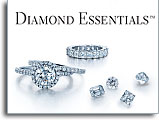Diamonds are forever. A girl’s
best friend. A gift for someone you love. These are all timeless statements
that extol the virtues of a hunk of ever humble carbon, that withstands
millions of years of pressure, and then crystallizes into a statement of
luxury, extravagance and sheer class.
In the first part of our
series, we catalogued some of the world’s favourite cuts or shapes of diamonds.
This part will further explain why the world is gaga for some particular,
diamond shapes. We will try to understand a little bit about the history of
these particular cuts and also their use in a particular item of covetousness,
i.e. their use in specific pieces of jewelry. So without further ado, here’s
the next set of the World’s most favourite shapes!
Oval Diamonds:
Created by noted jeweller
Lazare Kaplan in the 1960s, oval
diamonds are a modified brilliant-cut , which means they have facets that are mostly
triangular or kite shaped, and that radiate from the center.
They possess a fire and brilliance and fire very similar to round
diamonds and are a real favourite among jewelers, who use them to craft
exceptional rings, solitaire pendants
and the like. Stunning diamond solitaire rings are a unique statement of love
and have adorned the ring fingers of celebrities like Blake Lively, Sandra
Bullock and Salma Hayek.
 |
| Oval Diamond Ring |
Preferences vary on how narrow or fat an oval cut diamond should be,
though the accepted length to width ratio is generally 1.35 to 1, by the rule
of thumb say most craftsmen.
Marquise Diamonds:
The story of the Marquise Diamond is a romantic, if slightly twisted
one. It is said that King Louis XIV of France was in love with a noblewoman,
the Marquise of Pompadour. The lovestruck monarch is said to have commissioned
a diamond that was shaped after his beloved’s exquisitely perfect mouth! The
rest as they say is history… cute or bizarre ? You decide!Either way the
Marquise Diamond has become a firm favourite with diamond connoisseurs the
world over.
 |
| Marquise Diamond Ring |
A rugby football shaped, brilliant cut diamond, that tapers sharply at
its extremities, is said to be a perfect Marquise diamond. Because marquise
diamonds are long and narrow, they can also create the illusion of greater
size. Carat for carat, the marquise diamond has one of the largest crown
surface areas of any diamond shape, making it a good choice when trying to
maximize the perceived size of a diamond. Like the oval diamond, the marquise
cut diamond's elongated shape can make the finger of the wearer appear longer
and slimmer. This is very same reason why engagement rings made with Marquise diamonds are so much in demand.
Pear shaped Diamonds:
The best way to describe a Pear shaped diamond would be to call it the love child of an oval and
Marquise diamond. Quite simply because a pear shaped diamond combines in it the
shapeliness and characteristics of both the oval and Marquise diamonds.
Broad on one end, with a tapered opposite end, defines these brilliant-cut diamonds. This characteristic makes this diamond quite a
versatile shape to use in the creation of exquisite rings or solitaire
pendants.
A handy tip to remember when choosing such a diamond shape would be to
remember that a pear shaped diamond should possess
excellent or very good symmetry. The point should line up with the apex of the
rounded end. The shoulders and wings (the upper and lower curves on the right
and left side of the diamond) should form uniform, symmetrical curves, with no
straight edges. That’s when you know you have a ‘real gem’ on your hands!
References/Sources:








No comments:
Post a Comment